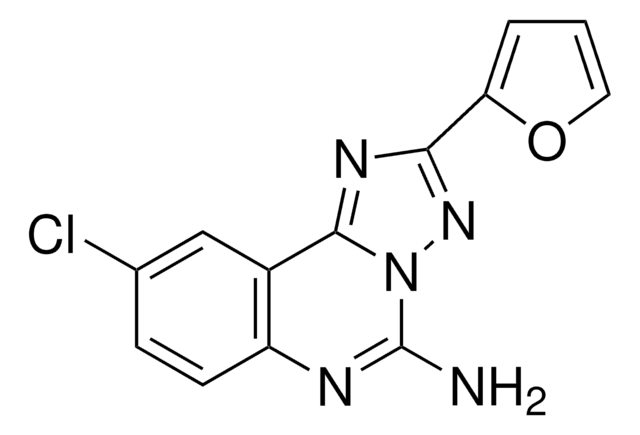SML2738
SM1-71
≥98% (HPLC)
Synonym(s):
N-[2-[[5-Chloro-2-[[4-(4-methyl-1-piperazinyl)phenyl]amino]-4-pyrimidinyl]amino]phenyl]-2-propenamide
Sign Into View Organizational & Contract Pricing
All Photos(1)
About This Item
Empirical Formula (Hill Notation):
C24H26ClN7O
CAS Number:
Molecular Weight:
463.96
UNSPSC Code:
12352200
NACRES:
NA.77
Recommended Products
Quality Level
Assay
≥98% (HPLC)
form
powder
color
white to beige
solubility
DMSO: 2 mg/mL, clear
storage temp.
2-8°C
Biochem/physiol Actions
SM1-71 is a cell penetrant and potent multi-targeted kinase inhibitor that engages kinases through both reversible and irreversible binding. SM1-71 covalently inhibits 23 kinases including MKNK2, MAP2K1/2/3/4/6/7, GAK, AAK1, BMP2K, MAP3K7, MAPKAPK5, GSK3A/B, MAPK1/3, SRC, YES1, FGFR1, ZAK(MLTK), MAP3K1, LIMK1, and RSK2. It binds to the cysteine located in vicinity of active site. In some cases, SM1-71 might bind to Cys located at allosteric places. SM1-71 potently inhibits growth of multiple cancer cell lines.
Storage Class Code
11 - Combustible Solids
WGK
WGK 3
Flash Point(F)
Not applicable
Flash Point(C)
Not applicable
Certificates of Analysis (COA)
Search for Certificates of Analysis (COA) by entering the products Lot/Batch Number. Lot and Batch Numbers can be found on a product’s label following the words ‘Lot’ or ‘Batch’.
Already Own This Product?
Find documentation for the products that you have recently purchased in the Document Library.
Li Tan et al.
Bioorganic & medicinal chemistry, 25(3), 838-846 (2016-12-25)
TAK1 (transforming growth factor-β-activated kinase 1) is an essential intracellular mediator of cytokine and growth factor signaling and a potential therapeutic target for the treatment of immune diseases and cancer. Herein we report development of a series of 2,4-disubstituted pyrimidine
Suman Rao et al.
The Journal of biological chemistry, 294(21), 8664-8673 (2019-03-13)
Most cancer cells are dependent on a network of deregulated signaling pathways for survival and are insensitive, or rapidly evolve resistance, to selective inhibitors aimed at a single target. For these reasons, drugs that target more than one protein (polypharmacology)
Suman Rao et al.
Cell chemical biology, 26(6), 818-829 (2019-04-16)
Covalent kinase inhibitors, which typically target cysteine residues, represent an important class of clinically relevant compounds. Approximately 215 kinases are known to have potentially targetable cysteines distributed across 18 spatially distinct locations proximal to the ATP-binding pocket. However, only 40
Our team of scientists has experience in all areas of research including Life Science, Material Science, Chemical Synthesis, Chromatography, Analytical and many others.
Contact Technical Service







